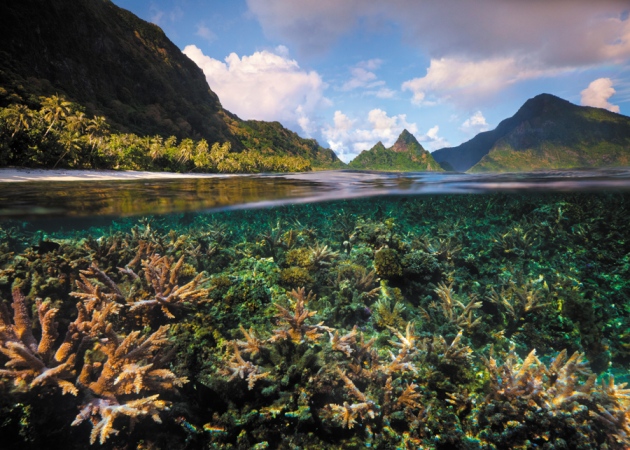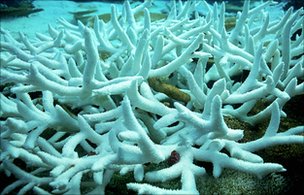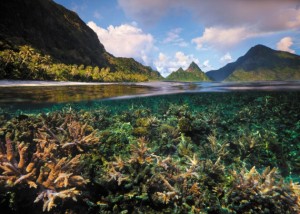April 27, 2014 – Coral reefs are the tropical forests of the ocean. They contain more biodiversity and are more under threat than any other parts of the ocean today. That’s because ocean temperatures and acidity are rising, both killers of coral. Since 1950, the ocean has seen 19% of its reefs die. Today another 35% are in critical condition. Not all areas of the ocean are equally affected. For example, the Caribbean has seen much greater losses than the average with 80% of its reefs dying off since the 1970s.
The warming of the ocean is one of two threats. The other is ocean acidification.
Why are both of these happening?
We know that the atmosphere responds to increased levels of CO2 by warming. That’s because CO2 is a greenhouse gas, absorbing solar radiation and converting it to heat. Over the last century our atmosphere has warmed 0.6 degrees Celsius (approximately 1.0 Fahrenheit). The oceans have been slower to warm as they too absorb heat from the surrounding atmosphere and from increased CO2. In comparison oceans have warmed on average 0.1 degrees Celsius (0.18 Fahrenheit). That warming extends through the water column to depths of 700 meters (2,300 feet). But the warming in the first 10 meters is more noticeable because surface water temperatures are already warmer than those further down.
Acidification comes from increased absorption of CO2. The ocean is the world’s primary carbon sequestering engine, more than forests or farmland. Approximately one-third of all CO2 we emit gets captured in water. The ocean is alkaline but CO2 is weakly acidic and when it dissolves in water on its own it forms carbonic acid. But in the ocean it just reduces alkalinity. And since we began measuring pH values in the ocean from the 19th century onward ocean waters have seen that pH level deline from 8.2 to 8.1. This trend is expected to continue throughout the remainder of the 21st century when pH levels drop to between 7.8 and 7.9. Why? Because the ocean will continue to absorb the CO2 we humans put into the atmosphere. At current concentrations of CO2 at 400 parts per million the ocean will continue to get more acidic. And if that atmospheric number reaches 450 then we should expect pH values to be closer to 7.8.
What does that mean for ocean life? Of all the creatures in our oceans two are most susceptible to the conditions we have created – warming and acidification.
The first is coral. The second is krill.
For coral warmer temperatures can mean death but not for all. But acidification is another story. It can inhibit construction of the reefs in which the coral live.
Coral is an unusual creature. It is a host to symbiotic algae which is critical to the coral’s survival. When coral is stressed it is the algae that dies first. The weakened coral then succumbs. Hence the bleaching that precedes the death of a reef.
For krill warmer waters and acidification inhibit reproduction. That means those animals that rely on krill such as whales and many species of fish will experience food scarcity. Any decline in the krill population, therefore, will impact the ocean food chain from bottom to the top.
In this posting we look at what some scientists believe they can do to combat the decline of coral reefs. You see not all corals are dying from a warming and acidifying ocean and scientists believe they can begin a program of selective breeding to take advantage of what has been observed.
For example corals off American Samoa, in the Pacific Ocean, (see image below) although exposed to water temperatures as high as 35 degrees Celsius (95 Fahrenheit) are not dying but in fact flourishing. Another reef has been observed off the coast of Taiwan near a wastewater outflow coming from a nuclear power plant where temperatures fluctuate 6 to 8 degrees Celsius (10 to 14 Fahrenheit) daily. It too is thriving in what would normally be considered a coral kill zone. At another location in the Pacific, off Palau, where pH levels are below the mean ocean average of 8.1, there are reefs flourishing.
What is making these corals more resilient? Scientists believe that some corals have thermal and acid tolerance built into their DNA. And it appears that these same corals are also transplant friendly so that they can be cultivated. There is research looking at hardier algae strains more resistant to ocean changes with the goal to incorporate these into corals. And plans are afoot to bank coral sperm, eggs and embryos with desirable traits to develop a program of seeding and outplanting for reefs currently in stress.
When you realize that more than a half billion of us depend on coral reefs as a food or income source focusing on reef recovery is critical.
How much more time have we got? We need to be turning the situation around over the next two decades so that by 2050 coral reefs are sustainable despite the effects of climate change.
As for how we can address the krill population challenge, that’s the subject of future blog posting.





















